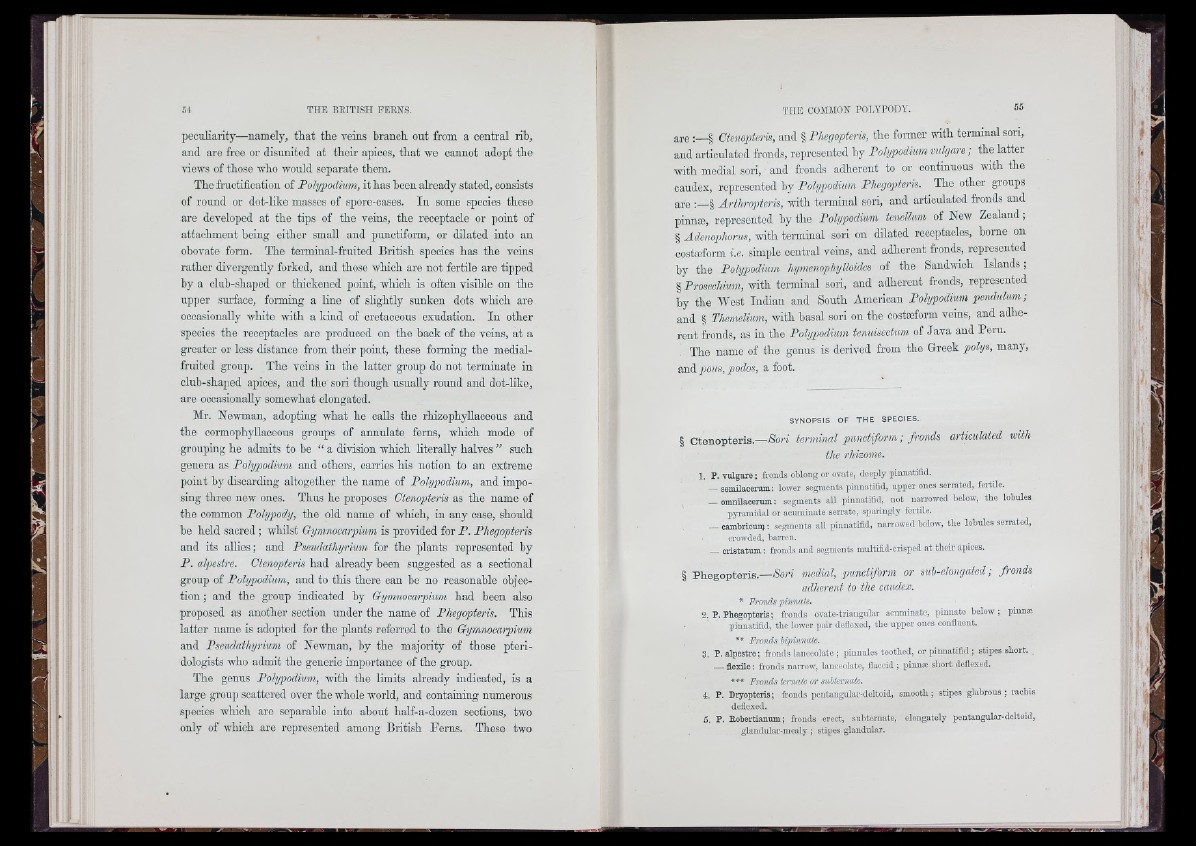
"4J
54 THE BEITISH EERNS,
peculiarity—namely, that the veins branch out from a central rib,
and are free or disunited at their apices, that we cannot adopt the
views of those who would separate them.
The fructification of Polypodmm, it has been abcady stated, consists
of round or dot-like masses of spore-oases. In some species these
are developed at the tips of the veins, the receptacle or point of
attachment being oitlier small and punotiform, or dilated into an
obovate form. The terminal-fruited British species has the veins
rather divergently forked, and those which are not fertile are tipped
hy a club-shaped or thickened point, which is often visible on the
upper surface, forming a lino of slightly sunken dots which are
occasionally white with a land of cretaceous exudation. In other
species the receptacles are produced on the hack of the veins, at a
greater or loss distance from thoir point, these forming the medial-
fruited group. The veins in the latter group do not terminate in
club-shaped apices, and the sori though usually round and dot-like,
are occasionally somewhat elongated.
Mr. Newman, adopting what he calls the rhizophyllaceous and
the cormophyllaocous groups of annulate ferns, which mode of
grouping he admits to be “ a division which literally halves ” such
genera as Pohjpodium and others, carries his notion to an extreme
point by discarding altogether the name of Polypodium, and imposing
three new ones. Thus he proposes Ctenopteris as the name of
the common Polypody, the old name of which, in any case, should
bo held sacred; whilst Gyrnnocarpium is provided for P. Phegopteris
and its allies; and Pseudathyrium for the plants represented by
P. alpestre. Ctenopteris bad already been suggested as a sectional
group of Polypodium, and to this there can be no reasonable objection
; and tbe group indicated by Gyrnnocarpium had been also
proposed as another section under the name of Phegopteris. This
latter name is adopted for the plants referred to the Gyrnnocarpium
and Pseudathyrium of Newman, hy the majority of those pteridologists
who admit the generic importance of tho group.
The genus Pohjpodium, with the limits already indicated, is a
largo group scattered over the whole world, and containing numerous
species which are separable into about half-a-dozen sections, two
only of which are represented among British Ferns. These two
are :—§ Ctenopteris, and § Phegopteris, the former with terminal son,
and articulated fronds, represented hy Pohjpodium vulgare; tbe latter
with medial sori, and fronds adliorcnt to or continuous with the
caudex, represented hy Pohjpodium Phegopiteris. The other groups
are :—§ Arthropteris, with terminal sori, and articulated fronds and
pinnæ, represented by tho Pohjpodium tenellum of New Zealand ;
§ Adenophoriis, with terminal sori on dilated receptacles, borne on
costæform i.e. simple central veins, and adherent fronds, represented
hy the Polypodium hymenophylloides of the Sandwich Islands ;
§ Prosechimn, with terminal sori, and adherent fronds, represented
hy the West Indian and South American Polypodium pendulum ;
and § Thenvtlium, with basal sori on the costæform veins, and adherent
fronds, as in the Pohjpodium tenuiseotum of Java and Peru.
The name of the genus is derived from the Greek polys, many,
and pous, podos, a foot.
SYNOPSIS OF TH E SPECIES.
ctenopteris.— Sori terminal punctiform; fronds articulated with
the rhizome.
1. P. v u lg a r e : fronds oLlong or ovate, deeply pinnatifid.
— semilacerum ; loiVer segments pinnatifld, upper ones serrated, fertile.
— omnüacerum; segments all pinnatifld, n o t nan-owed below, th e lobules
pyramidal or acumiuate senate, sparingly fertile.
— cambricun; ; segments all pinnatifid, narrowed below, th e lobules senated,
crowded, barren.
c r i s ta tum : fronds and segments multifid-crisped a t th e ir apices.
i Phegopteris.— Sori medial, punctiform or sub-elongated ; fronds
adherent to the caudex.
* Fronds fin n aU ,
2. p. Phegopter i s; fronds ovate-triangular acuminate, pinnate below ; pinnæ
pinnatifld, th e lower p air deflexed, tb e upper ones confluent.
** Pronds hifñnnaU.
3. P. alpestre ; fronds lanceolate ; pinnules toothed, or pinnatifid ; stipes short.
flexile : fronds narrow, lanceolate, flaccid ; pinnæ short deflexed.
*** pronds ternate or suhternata.
4. P. Dryopteris; fronds pentangular-deltoid, smooth; stipes g lab ro u s; rachis
deflexed.
5. P. Eobertianum; fronds erect, suhternate, elongately pentangular-deltoid,
glandular-mealy ; stipes glandular.
I?
i III
11' .-j